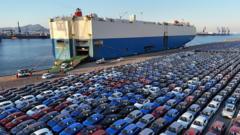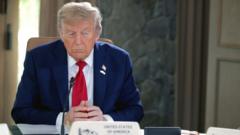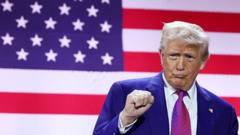Amidst ongoing speculation about the extent of the tariffs and countries affected, analysts warn of potential economic repercussions that extend beyond the U.S. borders.
**Uncertainty Looms Over Trump's Upcoming Tariffs as 'Liberation Day' Approaches**

**Uncertainty Looms Over Trump's Upcoming Tariffs as 'Liberation Day' Approaches**
As President Trump prepares to unveil his new tariff policies, confusion surrounds their scale and implications for global trade.
The countdown is on as President Trump's 'Liberation Day' tariffs are set to be announced, but critical details remain ambiguous. Trump’s administration has consistently hinted at significant changes, but some of the most pressing questions revolve around the scale and breadth of these tariffs. Analysts have noted that since Trump's presidency began, tariffs have already surged on a variety of imports, leading many to wonder how the upcoming policies will unfold.
Reports indicate that Trump may implement a comprehensive tariff plan, with possible rates discussed ranging from 10% to as high as 60% for imports from China. However, exactly how these tariffs will be structured is still unclear. The notion of 'reciprocal' tariffs proposed earlier this year suggests that these duties could vary by country, prompting businesses and leaders alike to speculate on the potential tariffs' impacts not just on trade but on operational costs as well.
The uncertainty extends to the list of countries that will be affected, with Trump hinting that the tariffs could potentially encompass “all countries.” This announcement dashed hopes of certain nations like the UK that had hoped to negotiate favorable terms. Key trading partners, including Canada and the European Union, are bracing for steep increases in import taxes, with estimates suggesting a 25% tariff on selected goods. Meanwhile, the focus of the administration appears to be on what they've termed the "Dirty 15," which includes nations perceived to impose unfair trade barriers against U.S. companies.
As businesses ponder the financial implications of these tariffs, they may face difficult choices. While companies generally absorb the cost of tariffs, many may not be able to avoid passing these expenses onto consumers. Pricing strategies will be critical, although drastic increases could result in decreased demand, potentially pushing the U.S. economy into a precarious position.
Trump has posited that businesses could circumvent these tariffs by shifting their operations domestically, an assertion met with skepticism given the realities of manufacturing costs and infrastructure requirements. With rising currency volatility and the looming threat of retaliatory measures from foreign governments, the trailers of the forthcoming tariff announcement could result in far-reaching and unpredictable outcomes that stretch well beyond U.S. borders.
Reports indicate that Trump may implement a comprehensive tariff plan, with possible rates discussed ranging from 10% to as high as 60% for imports from China. However, exactly how these tariffs will be structured is still unclear. The notion of 'reciprocal' tariffs proposed earlier this year suggests that these duties could vary by country, prompting businesses and leaders alike to speculate on the potential tariffs' impacts not just on trade but on operational costs as well.
The uncertainty extends to the list of countries that will be affected, with Trump hinting that the tariffs could potentially encompass “all countries.” This announcement dashed hopes of certain nations like the UK that had hoped to negotiate favorable terms. Key trading partners, including Canada and the European Union, are bracing for steep increases in import taxes, with estimates suggesting a 25% tariff on selected goods. Meanwhile, the focus of the administration appears to be on what they've termed the "Dirty 15," which includes nations perceived to impose unfair trade barriers against U.S. companies.
As businesses ponder the financial implications of these tariffs, they may face difficult choices. While companies generally absorb the cost of tariffs, many may not be able to avoid passing these expenses onto consumers. Pricing strategies will be critical, although drastic increases could result in decreased demand, potentially pushing the U.S. economy into a precarious position.
Trump has posited that businesses could circumvent these tariffs by shifting their operations domestically, an assertion met with skepticism given the realities of manufacturing costs and infrastructure requirements. With rising currency volatility and the looming threat of retaliatory measures from foreign governments, the trailers of the forthcoming tariff announcement could result in far-reaching and unpredictable outcomes that stretch well beyond U.S. borders.






















